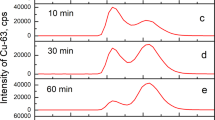Abstract
Features of the interaction of doxorubicin (DR) with Cu2+ ions of the active center of ceruloplasmin (CP) have been studied by electronic spectroscopy. It is established that DR · Cu2+ CP and DR complexes with inorganic copper salts (Cu(CH3COO)2 and CuSO4) have the same chromophore. An equation establishing a relationship between the electronic absorption at 540 nm (chromophore absorption region) and the concentration of DR involved in the complex formation is proposed. Using this dependence in accordance with the Benesi-Hildebrand theory, the complex formation constant was approximately evaluated as Kp = 4.5 × 106. Effective complex formation between DR and Cu2+ ions of the CP active center creates prerequisites for the removal of Cu2+ ions from CP and, consequently, for a decrease in CP oxidase activity.
Similar content being viewed by others
References
Pharmacopoeial Article FS 42-3369-97. Doxorubicin Hydrochloride. USSR State Pharmacopoeia (XIth Ed.) [in Russian], Moscow (1990), Vol. 2.
Ceruloplasmin. USSR State Pharmacopoeia (XIth Ed.) [in Russian], Moscow (1989), Vol. 2, p. 28.
H. A. Ravin, Lancet, 6925, 726–727 (1956).
T. A. Krainova, L. M. Efremova, Yu. K. Piskareva, et al., in: Herald of the Blood Services of Russia [in Russian], Moscow Society of Transfusion Specialists (2002), Issue 2.
A. L. Gershuns, A. A. Verezubova, and Zh. A. Tolstykh, Izv. Vyssh. Uchebn. Zaved., Khim. Khim. Tekhnol., 4(1), 25–27 (1961).
R. J. Good, “Solids: Contact Angles and the Surface Free Energy of Solids,” No. 4, 47–51 (1978).
Z. M. Qian and Y. Ke, Brain Res. Rev., 35(3), 287–294 (2001).
L. Ryden, in: Copper Protein and Copper Enzymes, L. Lontie (ed.), CRC Press, Boca Raton, Florida (1984), pp. 37–108.
P. Vachette, E. Dainese, V. B. Vasiliev, et al., J. Biol. Chem., 277(43), 40823–40831 (2002).
L. Calabrese, M. Carbonaro, and G. Musci, J. Biol. Chem., 263, 6480–6483 (1988).
V. B. Vasil’ev, and S. V. Kononova, Biokhimiya, 52, 387–395 (1987).
V. B. Vasil’ev, A. M. Kachurin, R. P. Rocco, et al., Biokhimiya, 61(2), 296–304 (1996).
Author information
Authors and Affiliations
Additional information
__________
Translated from Khimiko-Farmatsevticheskii Zhurnal, Vol. 40, No. 5, pp. 49–53, May, 2006.
Rights and permissions
About this article
Cite this article
Mel’nikova, N.B., Volkov, A.A., Kononova, S.V. et al. Doxorubicin complexes with copper ions of the active center of ceruloplasmin. Pharm Chem J 40, 284–288 (2006). https://doi.org/10.1007/s11094-006-0110-y
Received:
Issue Date:
DOI: https://doi.org/10.1007/s11094-006-0110-y




